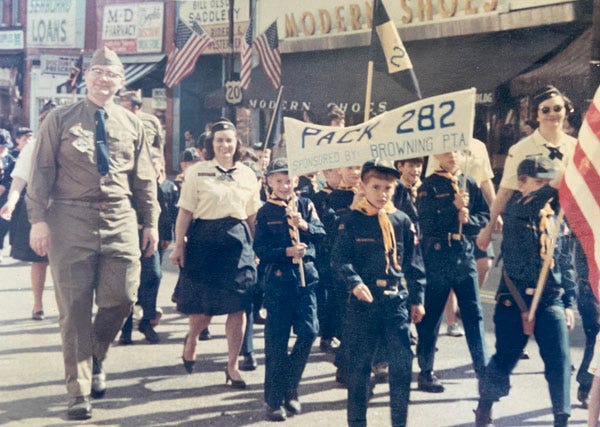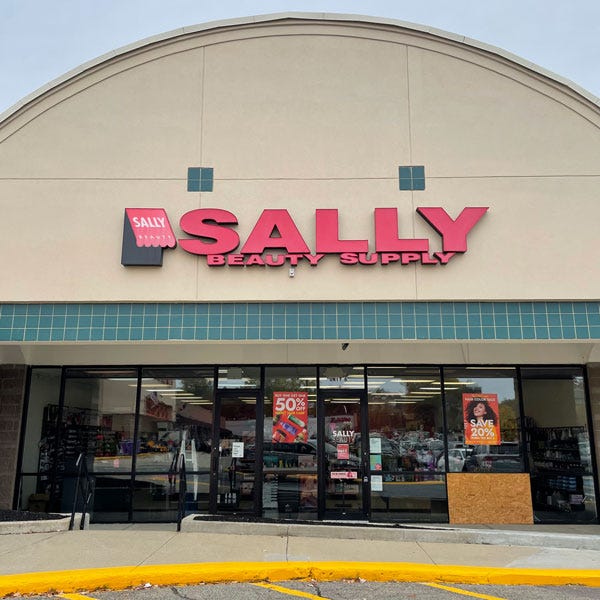Wednesday Walk: Main Street Leftovers
A downtown icon unexpectedly shows up in a strip mall, the relationship between zoning and our diet, and more bad weather for maple syrup
Welcome to Willoughby Hills!
As is typical every Wednesday, today I’m bring you a smattering of topics that I hope will make you a bit more curious about the world around you and give you something to think about later.
If you enjoy what you’re reading, please consider subscribing to receive emails every Wednesday and Sunday. It’s free, and there are also paid options with even more features.
The End of Maple Season
It’s been a while since I updated you all on the progress of my maple sugaring activities. The last I mentioned it, we were in a deep freeze that completely halted sap flow. Luckily, things thawed out a few days later, but then we were hit with successive snow storms.
Snow itself isn’t a problem for collecting and boiling sap, as long as the daytime highs reach above freezing and the nighttime lows drop below. But what got me was that my firewood ended up being buried in the snow, and each snowfall we had was the heavy, wet kind, which only soaked into the wood more.
Wet wood does not make a good fire, so I waited a bit and enjoyed the last bit of winter weather (that’s my daughter and me sledding in our backyard earlier this month). By the time the snow had melted and my firewood had dried out though, the sap was starting to turn yellow and the trees were budding out, which is the sign that maple season has passed.
I got three boils in this year and produced enough syrup for our needs plus some to share. I’ve been reading The Not So Big Life by architect Sarah Susanka, a self-help book based on her best-selling home series The Not So Big House. In Life, Susanka eloquently states that enough is enough and the opposite of enough is too much (I’m paraphrasing). Since I’m not a professional syrup maker, I decided that enough was indeed enough and I would be satisfied with the syrup that I was able to make early in the season.
I pulled the taps out of the trees this week and washed down all of my equipment to store for next year. For those of you wondering about the health of the trees, it’s pretty amazing how they can self-heal. Here’s the sap hole that I made in one of my maples two years ago and you can see that the hole has been completely sealed by new growth wood. Nature is amazing!
Main Street Leftovers
If you’ve been reading this newsletter for any length of time, you probably know that I have a deep fascination with old Main Streets and how that form has evolved into our suburban sprawl patterns.
Not long ago, I mentioned a Wal-Mart with a facade designed to look like a typical block of Main Street stores (that’s the photo again above).
wrote a piece last week for his newsletter titled “How Convenient are Supercenters?” where he argues that Wal-Marts offer a veneer of convenience over Main Street but actually function in much the same way:“In fact—if you superimposed a Walmart Supercenter over a small town—it’s pretty much as big as a real Main Street or small downtown! Think about it: you park far away; you walk to the store; you walk between departments, often back and forth; you often wait on line. The convenience is to some extent an illusion, because it’s all in one property and under one roof.”
Today I wanted to share another interesting vestige of Main Street that made it into a suburban shopping center in a very strange way. First, let me re-share a photo of my grandparents that was in Sunday’s newsletter about parades.
One thing that stands out to me in this photo from Willoughby, Ohio in the late 1960s is the number of awnings on the store fronts. There are at least three visible in this little half-block section of the Main Street (known as Erie Street in Willoughby), and this strip is about three blocks long on both sides of the street.
Awnings make sense on Main Street when you’re walking from store to store, exposed to the elements. They provide shade from the summer sun, plus protection from rain and snow on wetter days.
A few months ago, I was in Nashua, New Hampshire doing some shopping and decided to snap a photo of the front of Sally Beauty Supply, which is located in a typical strip mall next door to a Home Depot, a Patel Brothers grocery store, and a liquor store. Notice anything interesting?
While the shop itself has no awning (although you could argue that the tile band above the door is meant to imply one), for some reason the store’s sign has a little awning design incorporated into it. I am not a regular customer at Sally Beauty Supply (I may have been in the store once as a child with my mom), but there was something that struck me about the incorporation of an icon of Main Street in the middle of suburbia.
Almost like that “faux city block” Wal-Mart, I couldn’t tell if it was ironically using the image of an awning or genuinely trying to associate the brand with simpler times somehow. I also don’t recollect seeing this awning logo at any other Sally Beauty over the years, although I hadn’t really been looking for it either.
At any rate, I’m glad I photographed the awning sign when I did, because this past weekend I was back in the same plaza and here’s what greeted me:
Apparently, Sally Beauty Supply closed about 350 of its 3,700 locations in December. I was surprised that the chain operated that many locations to begin with (For comparison, Target has less than 2,000). I’m also surprised that they’re only closing about 10% of their shops, as struggling chains often close many more (home retailer Tuesday Morning is closing half of their 400 stores as part of a bankruptcy announced last month).
Again, I have almost no first hand knowledge or experience with Sally Beauty Supply, but I found an interesting piece for Business Insider by Ann Matica touring a Sally store in Manhattan. Her conclusion was that the Sally model just isn’t relevant anymore:
“Because most of the store is dedicated to hair care, Sally Beauty's offerings can’t compete with other beauty store retailers like Sephora or Ulta, which sell a larger selection of makeup, skincare, and fragrances. It also doesn't match up to many drug stores that have similar prices and more variety overall.”
Whatever happens to Sally Beauty Supply, I hope there’s a handful of stores somewhere that still have a random awning on their sign, even if they don’t have an awning on the store itself.
Invisible Hands
Finally this week, I wanted to share a few thoughts on the invisible forces at work that dictate the shape of our lives.

I stumbled upon an interesting piece by Christian Britschgi for Reason titled “The Zoning Theory of Everything.” In it, Britschgi draws connections between zoning policy and everything from the Great Recession to the election of Donald Trump.
Zoning laws are designed to separate various uses in a community. In theory, the idea is that a factory won’t be built next to a neighborhood of houses, which shouldn’t abut a shopping center.
In practice however, separating uses can have a devastating effect on the very residents it’s trying to protect. Walking to a corner store to buy a few groceries is impossible in many suburbs, because the single family houses are all grouped in one area, shopping is grouped in another, and office spaces or industrial spaces are still in another. (I wrote about this issue as it relates to Nashua, NH a few weeks ago).
With each use segregated, a car is required to complete even the most mundane or smallest tasks.
Quoting from Britschgi’s piece, here’s how he explains zoning and the role it plays in our lives:
“Whether a disused shed stays cluttered with rusty lawn care equipment, is turned into a home business, or is converted into an in-law suite might not seem like a major decision. But the existence of a whole body of laws dedicated to controlling that decision tells you how far zoning reaches into American lives. The consequences of these laws are as far-reaching as they are devastating.”
So how did zoning policy that only allowed for spread out, suburban development lead to the Great Recession? Here’s how Britschgi explains it:
“The conventional view of the Great Recession is that excess demand for housing—caused by some combination of loose monetary policy, government-subsidized credit, and unscrupulous lenders—inflated a bubble that inevitably had to pop…. But it's wrong, according to Kevin Erdmann, a senior affiliated scholar at George Mason University's Mercatus Center…
In a 2020 paper on the origins of the recession, Erdmann and economist Scott Sumner argue that… prices were increasing fastest in coastal ‘closed access’ cities like New York and San Francisco, where the economy was booming but restrictive zoning regulations prevented much new housing from being built. The result was an out-migration of lower-income people to ‘contagion cities’ in Nevada, Florida, Arizona, and other places where home building was less regulated. Erdmann and Sumner lay the housing crisis directly at the feet of NIMBYs—’not in my backyard’ activists who opposed the construction of new housing.
…Erdmann and Sumner argue the Great Recession was ultimately caused by federal officials misinterpreting rising home prices as a bubble rather than the result of a real shortage. So they tightened monetary and lending policy, and that tipped a rational building boom into an artificially induced recession.
…it does explain how the country was able to go from a supposed glut of housing oversupply to a shortage of somewhere between 4 million and 20 million homes. The glut was overinterpreted—and the shortage never went away.”
He goes on to explain how the Great Recession led to political instability, giving rise to the Tea Party movement on the Right and the Occupy movement on the Left. Donald Trump capitalized on some of this instability, using rhetoric about restoring the suburbs and enacting policies once in office to that effect.
We now find ourselves in a housing crisis where there is limited inventory, all priced very highly, and fewer skilled tradespeople to build the houses needed to get us out of this deficit. Furthermore, zoning laws and other policies favor single family homes rather than higher density buildings that could have a more immediate impact on our housing shortage.
The piece is a deep dive into a subject that most people outside of urbanist circles may not even be aware of, but it’s an interesting read.
On a related note, I wanted to share an episode of Dr. Mark Hyman’s podcast The Doctor’s Farmacy where he speaks with Calley Means about the hidden connections between the food we eat, the drugs we are prescribed, and health insurance.
Means was a former lobbyist who worked for Coca Cola who saw how big food was sponsoring research studies that made their products seem safe or even healthy.
As one example, he cites a study that was published in the Annals of Internal Medicine which concluded that evidence about added sugar in our diets causing harm was low quality and should not be considered trustworthy. Quoting from Means on the podcast:
“In other words, there's no evidence that sugar is harmful and we should be not promoting this through policy and consumers should not change their behavior because of any public perception that sugar is bad for you because according to the data, it's not. This study was funded by the International Life Science Institute, which is funded by Coca-Cola, General Mills, Hershey's, Kellogg, Kraft, McDonald's, Monsanto, Nestle, Pepsi, Coke, Proctor and Gamble. The lead author of the study is on the board of one of the largest makers of high fructose corn syrup.”
I’ve been aware of these connections for a long time, and it’s part of the reason that we are so obsessive about sourcing foods locally from trusted suppliers and following the dietary advice of Dr. Steven Gundry, who I interviewed on the podcast last year.
As Means says at one point in the podcast:
“…we are unequivocally becoming sicker, fatter, more depressed, more infertile based on our food. And we would expect the health care and our medical systems to be ringing the alarm bell on that, but they're silent because they're profiting.”
Like uncovering the hidden ways that zoning affects our lives, the interview on Dr. Mark Hyman’s show looks at the connection between the big ag, big food, and big pharma and makes connections that may otherwise have seemed hidden or insignificant. I highly recommend taking a few minutes to give it a listen!
Thank you for reading! I always love hearing your thoughts, so please drop a line in the comments.
I publish new issues every Wednesday and Sunday. Sign up to always receive the latest issue and support my work:
Other Wednesday Walks
Please consider sharing this with a friend that you think might enjoy it or you can post it on social media.
If you’ve missed past issues of this newsletter, they are available to read here.
Stay Safe!
Heath











